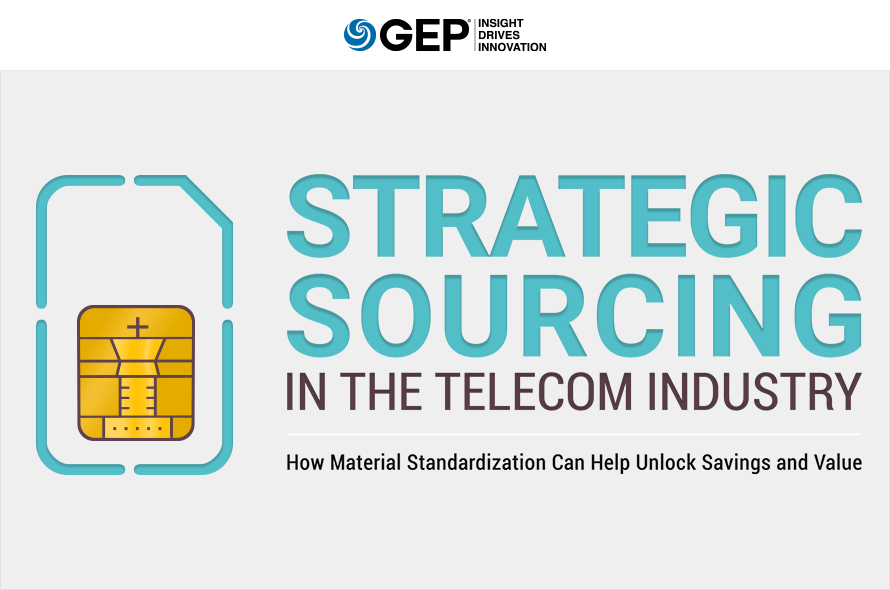It’s an irony of sorts. Recent M&As have led to consolidation of the telecom industry. However, they have also resulted in a lot of redundant stock keeping unit (SKU) inventory, limiting the synergy value of M&A deals.
One effective solution to optimize SKU inventory is material standardization.
In a new paper — Strategic Sourcing in the Telecom Industry: How Material Standardization Can Help Unlock Savings and Value — GEP’s telecom industry experts discuss how SKU standardization can help achieve inventory reductions, enhanced sourcing leverage and significant cost savings. They also share five key considerations to help you make the most from your material standardization program.
Why Read It:
- Understand the need for SKU standardization
- How strategic sourcing can help standardize materials
- Five key considerations to ensure success of your standardization program
It’s recommended reading for all sourcing and procurement pros in telecom companies looking to enhance savings and value.
Overview
It’s a little ironic. Because of multiple mergers and acquisitions, there are fewer and fewer communications companies than ever before, but as a result, these companies have more and more stock keeping units (SKUs) to manage in inventory. It’s a simple, if troubling equation: more SKUs equals even more time needed to deal with sourcing, purchasing, and process oversight.
Engineered commodities like enclosures, cabling, drop amps, line connectors, tools, safety supplies — all necessary to keep in stock — have not been standardized. This multiplicity of SKUs adds unnecessary layers of complexity, leading to operational challenges that directly impact administration, workflow and cost efficiencies.
In other words, it’s a mess!
If you’re a sourcing manager at a communications company, you’re faced with the reality that the old ways of doing things just won’t drive the same value anymore. After decades of rapid growth, communications companies have plateaued. Purchasing volumes are flat, tending toward decreasing. The advantages of low-cost country sourcing have largely been reaped. And price concessions from vendors are getting harder to secure. You need to find a better way. The good news is that there is one.
The goal of this paper is to explain why focusing on material standardization is the next logical step for telecom companies to drive value. Among the benefits? Significant cost savings, enhanced buying leverage, gains in the quality of goods acquired, and inventory reductions. And that’s just the start. There are operational and even cultural improvements to be gained as well, with greater synchronicity between sourcing and engineering departments.

The Case for Part Standardization: Why Less Means More
Reducing the number of SKUs in inventory achieves a number of immediate benefits for the organization as a whole. With fewer inventory items to source, economies of scale can be gained through volume-based discounts. Plus, sourcing takes less administrative time, enabling greater focus and scrutiny on the quality of the materials being purchased.
At the same time, the consolidation of SKUs results in less inventory overall, reducing financial carrying costs as well as operational costs.
Likewise, there will also be fewer suppliers. Sourcing managers can take advantage of greater buying leverage with the suppliers they choose — not just in terms of the ability to negotiate lower prices, but also in the ability to shape specifications.
Why Streamlining the Supply Chain Is Now an Essential Business Strategy
Among the biggest problems that sourcing managers face is the use of multiple engineering standards, resulting in multiple SKUs. It’s an administrative nightmare of unnecessary complexity. And it hobbles buying power because only relatively low volumes are needed for a single SKU.
The solution lies astride two departments that have, frankly, tended to work at odds with one another: Sourcing and Engineering. But by working with Engineering to establish a comprehensive catalogue of materials defined by key functional attributes — and defined by actual engineers — Sourcing can help implement true standardization that in turn can be leveraged in the market for greater value.

One major communications provider recently worked with a procurement strategy consultant to conduct a trial run of this new, collaborative process.
The results were extraordinary: By streamlining the supply chain through standardization, the company was able to drive the following outcomes across three critical areas:
- Cost savings of 10-15%
- SKU reductions of over 50%
- Inventory improvements of 33%
As noted earlier, a reduction in costs does not translate into a “race to the bottom” in terms of quality; in fact, the opposite is usually true. Quality is higher because Engineering is directly involved in setting the standards, and of course there are cost advantages to buying in greater volumes. Standardizing from three materials to one means that the “highest quality” material can be selected and that the resulting leverage will still enable a lower price per unit than the three materials being purchased separately.
Why use sourcing to drive standardization?
More buying leverage creates economies of scale
Volume-based discounts can be achieved by consolidating the order quantity to a single supplier.
Less complexity helps streamline procurement
Well-defined SKUs and fewer suppliers make the procurement process more efficient and free up time to focus on value-added supplier relationships.
Fewer SKUs helps manage inventory and maintain quality control
A decrease in the number of SKUs enables lower inventory, easier inventory management, and improvements in product quality.
A better relationship between Sourcing and Engineering helps streamline workflow
With standardized and clear technical specifications, communication between Sourcing and Engineering becomes clearer.

Where to Start: Important Considerations for
a Standardization Initiative
A sourcing solution that employs standardization is only as effective as the data that drives it. Without accurate, comprehensive, functional information about each SKU, it would be impossible to reap the full benefits of standardization. Here are five important considerations to keep in mind:
1. Align with your organization’s engineering leadership
Standardization is not a one-off project. It’s not commodity-specific. It’s an ongoing change to the way sourcing is being done across the entire supply chain — a change for the better, for everyone. By gaining the support of Engineering, getting it involved at the outset, and enabling it to drive the standardization decisions, you help ensure the process is embraced and continues to be employed.
2. Establish a methodology for SKU standardization
Have a complete list of all SKUs by category, application and quantity. Identify SKUs with multiple suppliers and similar technical specifications, check for any differences in their pricing and order quantity, and evaluate the potential savings after consolidation.
Engineering drives the standardization decisions, while Sourcing facilitates the estimated cost savings under different scenarios.
3. Ensure you have comprehensive technical specifications and details
A detailed analysis of technical and functional aspects of each item is required to determine the feasibility of standardization. This requires engineering expertise. Often, detailed specifications of products are not always available, so ensure you have a clear set of description criteria for each item in each category.
4. Align standardized SKUs by supplier and spend
This helps inform any bidding process initiated by procurement to suppliers. They can then be invited to submit pricing proposals that can be assessed more accurately, enabling procurement to either renew old contracts or develop new ones.
5. Do a pilot first
Yes, a complete transformation of the relationship between Sourcing and Engineering is the ultimate goal, but don’t try to do it all at once. Begin instead with a set of commodities that are related, starting with simpler ones first. By performing the rollout incrementally by category, you can help ensure continued success, starting with the ability to source higher- quality items that will be used universally.
It’s important to emphasize that Sourcing and Engineering must work in concert to help ensure standardization is implemented successfully. With a common set of goals in place, Sourcing and Engineering can have a productive relationship that will help drive business performance for communications enterprises in measurable, mutually beneficial ways.


